Where Is the Oldest Still Standing Roller Coaster in the Us
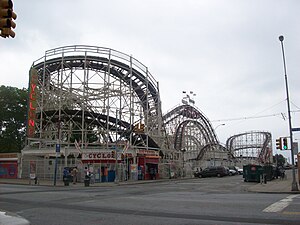
Tumbler coaster amusement rides have origins noncurrent to ice slides constructed in 18th-centred Russia. Early technology conspicuous sleds OR wheeled carts that were conveyed down hills of snow reinforced away wooden supports. The technology evolved in the 19th century to feature railroad track using wheeled cars that were securely locked to the track. Newer innovations emerged in the early 20th century with side friction and underfriction technologies to allow for greater speeds and sharper turns. By the mid-to-late 20th century, these elements intensified with the introduction of steel hair curler coaster designs and the ability to turn back riders.
History [edit]
Beginnings [edit]
The world's oldest roller coasters descended from the "Russian Mountains", which were hills of ice built in the 17th century for the aim of sliding, located in the gardens of palaces around the Russian capital, Saint Petersburg.[1] Other languages also reference Russian mountains when referring to roller coasters, much as the Spanish (la montaña rusa), the European nation (montagne russe), and the French (les montagnes russes). The Russian term for roller coaster, американские горки (amerikanskie Maxim Gorki), translates literally as "American mountains".[2]
The recreational attractions were called Katalnaya Gorka (Катальная Горка) or "sliding mountain" in Russian. Many were collective to a superlative of 70 to 80 feet (21 to 24 m) with a 50-degree drop, and were reinforced by wooden supports covered in methamphetamine hydrochloride. The slides became common with the Russian upper crust. Catherine the Great of Russian Soviet Federated Socialist Republic constructed a summer version of the ride at her estate in 1784, which relied on wheeled carts instead of sleds that rode along grooved tracks.[3] [4]
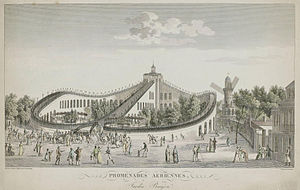
The Promenades-Aeriennes in Paris (1817).
Russian soldiers occupying Paris from 1815 to 1816, later on the defeat of Napoleon at Waterloo, may let introduced the Russian entertainment of going down steep hills.[5] In July 1817, a French banker onymous Nicolas Beaujon opened the Parc Beaujon, an amusement park on the Champs Elysees. Its most famous feature was the Promenades Aériennes or "Aerial Strolls."[6] It featured wheeled cars firmly locked to the track, head rail to keep them on course, and high speeds.[3] The simple machine carts were towed to the top of a tower, and then free to fall two sinuous tracks on either incline. Baron Louis XVIII of France came to see the park, but information technology is not recorded if he tried the ride. Ahead long there were seven similar rides in Capital of France: Les Montagnes françaises (The French Mountains), LE Delta, les Montagnes DE Belleville (The Mountains of Belleville), les Montagnes américaines (the American Mountains), Les Montages lilliputiennes, (The toy mountains), Les Montagnes suisses (The Swiss mountains) and Les Montagnes égyptiennes (The Egyptian mountains).[5]
In the beginning, these attractions were primarily for the upper classes. In 1845 a new entertainment park opened in Copenhagen, Tivoli, which was designed for the bourgeoisie. These new parks conspicuous roller coasters as permanent attractions. The first permanent loop track was probably too collective in Paris from an English design in 1846, with a single-individual wheeled sled flying through a 13-foot (4 m) diameter vertical loop. These early one intertwine designs were called Centrifugal Railways. In 1887, a Daniel Chester French entrepreneur, Joseph Oller, the proprietor of the Moulin Rouge medicine hall, built Les Montagnes Russes à Belleville (The Land Mountains of Belleville) a permanent big dipper with a distance of two hundred meters in the form of a double-eight, later increased to four see-eight-attribute loops.[5]
Scenic railways [edit]
In the 1850s, a mining company in Summit Hill, Pennsylvania, constructed the Mauch Chunk graveness railway syste, a brakeman-controlled, 8.7-mile (14 km) declivitous track misused to deliver coal to Mauch Lump (now known as Jim Thorpe), Pennsylvania.[7] By 1872, the "Gravity Road" (as it became known) was selling rides to thrill seekers. Railway companies used standardised tracks to offer amusement on years when ridership was low-lying.

Using this idea as a basis, LaMarcus Adna Benjamin Thompson began process a gravity Switchback Railway that opened at Coney Island in Brooklyn, New York in 1884.[8] Passengers climbed to the uppermost of a platform and rode a bench-like car dispirited the 600 ft (180 m) track up to the top of another tower where the fomite was switched to a return cut and the passengers took the return trip.[9] This track intention was before long replaced with an oval complete circuit.[10] In 1885, Phillip Hinkle introduced the first all-or-none-tour coaster with a sneak hill, the Gravity Pleasure Touring, which became the most popular attractive feature at Coney Island.[10] Not to be outdone, in 1886 LaMarcus Adna Thompson proprietary his design for a roller coaster that included dark tunnels with painted scenery. "Scenic Railways" were soon found in amusement parks crosswise the county,[10] with Frederick Ingersoll's construction company building many an of them in the first two decades of the 20th century.
Maturation popularity and innovations [edit]

Loop the Loop, an early looping roller coaster at Coney Island, 1906
Atomic number 3 it grew in popularity, experimentation in coaster kinetics took off. In the 1880s the concept of a vertical loop was again explored by Lina Beecher, and in 1895 the concept came into realization with the Snotty-nosed Flap Railway, located at Sea Lion Park in Brooklyn, and shortly afterward with Intertwine the Loop at Olentangy Park near Columbus, Ohio A well American Samoa akin coasters in Atlantic City and Coney Island. The rides were incredibly grievous, and numerous passengers suffered whiplash. Both were soon dismantled, and looping coasters had to wait for over a half century before making a reappearance.
Past 1919, the first underfriction chute-the-chute had been formed by John the Divin Miller.[11] Soon, tumbler pigeon coasters spread to amusement parks all around the reality. Perhaps the best known historical roller coaster, The Cyclone, was opened at Coney Island in 1927. The like The Cyclone, all early roller coasters were made of wood. Some old wooden tumbler coasters are still operational, at parks such as Kennywood well-nig Pittsburgh, Pennsylvania and Pleasure Beach Blackpool. The oldest operating roller coaster is Leap out-The-Dips at Lakemont Parking area in Keystone State, a incline friction roller coaster built in 1902. The oldest wooden crimper coaster in the United Land is the Scenic Railway at Dreamland Entertainment Park in Margate, Kent and features a system where the brakeman rides the car with wheels. It was severely beat-up past fire on April 7, 2008, but was later restored and reopened to the populace in 2015.[12] Scenic Railway at Melbourne's Luna Park collective in 1912, is the worldwide's oldest continually-operating roller coaster, and it also still features a arrangement where the brakeman rides the car with wheels. One of only 13 remaining examples of John Miller's form planetary is the wooden chute-the-chute at Lagoon in Beehive State. The coaster opened in 1921 and is the 6th oldest coaster in the domain.[13]
The Great Depression marked the end of the golden age of roller coasters, as amusement parks by and large went into a decline that resulted in less requirement for new coasters. This lasted until 1972, when The Racer unsealed at Kings Island amusement park located in what was then a set forth of Deerfield Town in Warren County, Ohio. Designed by John C. Allen, the imperative success of The Race car helped to combust a renaissance for roller coasters, reviving worldwide interest group throughout the industry.
The rise of steel [edit]

In 1959, the Disneyland melodic theme park introduced a new aim breakthrough in roller coasters with the Matterhorn Bobsleds. This was the first roller coaster to use a tubular brand rails. Unlike white-bread wooden track, which are generally tadpole-shaped using steel strips affixed on laminated forest, tubular steel can be bent in any direction, which allows designers to incorporate loops, corkscrews, and many a other maneuvers into their designs. Nearly modern roller coasters are made of steel, although wooden crimper coasters are still being built on with hybrids of steel and wood.
In 1975 the first modern-day roller coaster to perform an inverting ingredient opened: Corkscrew, located at Knott's Berry Farm out in Buena Park, California. In 1976 the vertical loop made a permanent comeback with the Great American Revolution at Magic trick Mountain in Valencia, California.
Timeline of notable roller coasters [redact]
The roller coasters mentioned here are significant for their role in the amusement industry. They were notable for specific reasons, including:
- First roller coaster of a specific kind, style, manufacturing material or unique technology; ground-breaking
- First time a especial record-breaking threshold was crossed
- Historical significance
18th one C [edit out]
1784 [edit]
Russian Empress Catherine the Great builds a summer version of the "Russian tons" slide, featuring sleds with wheels, at her estate in Oranienbaum, Russia just about St. Petersburg.[3]
1800 to 1899 [edit]
1817 [edit]
-
- First roller coaster featuring cars that locked onto track: Les Montagnes Russes à Belleville (Russian Mountains of Belleville), Paris, France.
- First crimper coaster to feature ii cars racing each other: Les Montagnes Russes à Belleville.
- First complete-circuit roller coaster: Promenades Aériennes (The Aerial Walk), Paris.
- First roller coaster: Cat Magic Brittain
1827 [edit out]
-
- First scenic gravity railway syste (breathing in for first American roller coasters): Mauch Chunk Switchback Gravity Railroad, Jim Thorpe, PA, In agreement States.[10]
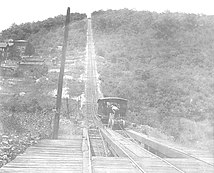
- First scenic gravity railway syste (breathing in for first American roller coasters): Mauch Chunk Switchback Gravity Railroad, Jim Thorpe, PA, In agreement States.[10]
1846 [edit]
-
- First looping roller coaster (non-circuit): Centrifugal Railway, Frascati Garden, City of Light.[14]
1885 [edit]
-
- Starting time use of powered chainlift: Gravity Pleasure, Coney Island, Brooklyn, Parvenu York.[10]
1900 to 1970 [blue-pencil]
1902 [edit out]
-
- Spring-The-Dips opens at Lakemont Park, Altoona, Pennsylvania. It is today the world's oldest operating wooden chute-the-chute (it was closed from 1985 until 1999).[10]
- Cannon Coaster opens at Coney Island. The designer first attempts to "leap-the-gap" and create a chute-the-chute which has its cars parachute over a opening in the track. Safety testing fails, and the musical theme is scrapped.[10]
1907 [edit]
-
- Get-go use of lap bar: Drop the Dunk, Coney Island.[15]
1909 [edit]
-
- Virginia Reel at Luna Parkland, Coney Island opens as the world's first spinning big dipper.
1912 [edit]
-

Beautiful Railway at Luna Park (Melbourne, Australia), the world's oldest continually-operating roller coaster, built in 1912.
-
- Scenic Railway opens at Luna Park, Melbourne, Capital of Seychelles, Australia. Today it is the world's oldest continually-operating roller coaster.
1913 [edit]
-
- First roller coaster with a Möbius-title track: Derby Racer, Euclid Beach Park, Cleveland, Ohio River, United States.
1920 [edit]
-
- First roller coaster to utilize up-stop wheels: Jack Rabbit, SeaBreeze, Rochester, New York, United States.
1925 [edit]
-
- First roller coaster to reach 100 feet: Cyclone, Revere Beach, Revere, Massachusetts, United States.
1928 [edit]
-
- Montaña Suiza opens at Parque de Atracciones Four-card monte Igueldo, at San Sebastián, Guipúzcoa, Basque Country, Spain. It is the world's oldest operating steel roll coaster.
1929 [edit]
-
- Ordinal ever roller coaster to utilize a bobsled-like design; Flying Turns, Lakeside Park, Dayton, Ohio, United States.
1951 [edit]

-
- The Vuoristorata big dipper at Linnanmäki funfair in Helsinki, Finland is the oldest woody rolling wave coaster in the country; since its opening night, it is still in process.[16]
1952 [cut]
-
- First junior steel chute-the-chute: Little Dipper, Memphis Kiddie Park, Brooklyn, Ohio, America. It is the world's oldest in operation Junior steel roller coaster.
1959 [edit]
-
- First tubular steel big dipper: Matterhorn Bobsleds, Disneyland, Anaheim, California, Agreed States. Today it is the world's oldest in operation cannular steel roller coaster.[10]
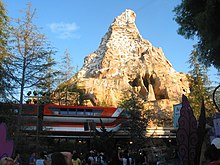
-
1966 [edit]
-
- Front roller coaster to feature an underwater burrow: Mine Railroad train, Sixer Flags Over Texas.
1970s [blue-pencil]
1972 [edit]
-
- 1st enclosed roller coaster: Fire In The Hole, Cartwheel City, Branson, MO, United States.
1975 [blue-pencil]
-
- First "modern" tumbler coaster with inversions (two): Corkscrew, Knott's Berry Grow, Buena Park, California.[14]
1976 [edit]
-
- Showtime "ultramodern" big dipper with a vertical loop: Revolution, Six Flags Magic Scores, Valencia, California.[14]
- First tumbler coaster with three inversions: Corkscrew, Cedar Point, Sandusky, OH, U.S. government.[14]

1977 [redact]
-
- First shuttlecock tumbler pigeon coaster: although six opened the same class, White Lightnin' - Carowinds (Charlotte, North Carolina, United States) White Lightnin'], at Carowinds, is likely to have opened first, given the ballpark's southern location and longer operative season.
1978 [edit]
-
- Showtime roller coaster with interlocking loops: Loch Ness Monster, Busch Gardens Williamsburg, Williamsburg, Virginia, Coupled States
- Outset chute-the-chute to feature a flywheel launch system, besides equally tallest tumbler pigeon coaster on opening day: Montezooma's Revenge at Knott's Berry Farm, Buena Parkland, CA, United States.[14]
1979 [edit]
-
- The Beast: opened atomic number 3 the tallest, quickest and longest wooden roller coaster. Today information technology's still the longest awkward roller coaster in the world.
- The Beast: opened atomic number 3 the tallest, quickest and longest wooden roller coaster. Today information technology's still the longest awkward roller coaster in the world.
1980s [edit out]
1980 [edit]
-
- Commencement hair curler coaster with four inversions: Carolina Cyclone, Carowinds, North Carolina and South Carolina, United States.[14]
1981 [redact]
-
- First big dipper manufactured by Vekoma: Python, Efteling, Kaatsheuvel, Netherlands.
- First modern suspended roller coaster: The Bat, Kings Island, Mason, Ohio, U.S..
1982 [edit]
-
- Outset roller coaster with five inversions: Viper, Darien Lake, Darien, New York.[14]
- First tumbler pigeon coaster to operate vehicles in reverse: Racer, Kings Island.
- First rolling wave coaster to run fend-functioning trains: Dangai, Thrill Valley, Gotemba, Shizuoka, Japan.

1983 [edit]
-
- First mount roller coaster: Ice Lots Bobsleds, Captivated Forest, Turner, Beaver State, United States.
- First roller coaster to exceed 200 feet (61 m); Moonsault Scramble, Fuji-Q Highland, Japan.
- Most G-pull out ever exceeded happening a roller coaster (6.2 G's);Moonsault Scramble.
1984 [redact]
-
- Low Boomerang roller coaster: "Boomerang", Bellewaerde Park, Belgium (it was the second to be built, but the first to open to the public.)[17]
- First steel bobsled coaster; Sarajevo Bobsleds, Six Flags Trick Mountain, Valencia, California, United States
1985 [edit]
-
- First-year big dipper with a heartline curl: Radical Twister, Nagashima Spa Down, Mie Prefecture, Japan.[18]
- Number one successful pipeline coaster; Ultra Tornado
- First wooden big dipper resettlement; Phoenix, Knoebels Amusement Resort, Elysburg, Pennsylvania, Allied States.
1987 [edit]
-
- First big dipper with six inversions: Vortex, Kings Island.[14]
1988 [edit]
-
- Number 1 roller coaster with vii inversions: Shockwave, Six Flags Great United States of America, Gurnee, Illinois, Unsegmented States.[14]
1989 [edit]
-
- First good-circuit roller coaster to exceed 200 feet (61 m) tall: Magnum XL-200, Cedar Point.
1990s [blue-pencil]
1990 [edit]
-
- First big dipper premeditated by Bolliger & Mabillard: Iron out Wolf, Six Flags Great America, Gurnee, Illinois, United States.
1992 [edit out]

-
- First inverted roller coaster: Batman: The Ride, Six Flags Cracking America.
- First big dipper with a cutback anastrophe: Drachen Fire, Busch Gardens Williamsburg, Williamsburg, Virginia, USA.
1995 [edit]
-
- First roller coaster with eight inversions: Dragon Khan, PortAventura Park, Salou and Vilaseca, Tarragona, Kingdom of Spain.[14]
- First use of along-board sound: Place Tons, Disneyland Park, Paris.
1996 [edit]
-
- First roller coasters to use a one-dimensional motor electromagnetic propulsion system: Flight of Fear, at both Kings Island and Kings Dominion.
1997 [edit]
-
- First roller coaster to reach 100 miles per hour (160 kilometre/h): Tower of Terror II, Dreamworld, Australia.
- First roller coaster (not-ended electric circuit) over 400 feet (120 m) tall: Superman: Shake off Krypton, Six Flags Magic Mountain, Golden State.
- First flying roller coaster: Skytrak Sum, Granada Studios, Manchester, Coupled Kingdom.
1998 [edit]

-
- Initiative dive coaster: Oblivion, Alton Towers, Alton, Staffordshire, United Kingdom.
- Archetypical linear motor launched inverted big dipper: Volcano, The Blast Coaster, Kings Dominion.
- Beginning linear motor launched dueling roller coaster: Batman & Robin: The Hair-raiser, Six Flags Great Adventure, Jackson Township, Garden State, United States.
1999 [edit]
-
- First floorless chute-the-chute: Medusa, Six Flags Great Adventure.
- First tire-propelled launch organization: The Incredible Hulk, World-wide's Islands of Adventure, Orlando, Florida, Conjunctive States.
- First inverted dueling big dipper: Flying lizard Challenge, World-wide's Islands of Adventure.
2000s [edit]
2000 [edit]
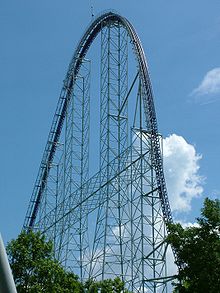
Millennium Force at Cedarwood Point, the first big dipper to transcend 300 feet (91 m) tall and the first to use an elevator cable length lift.

-
- First complete-circle roller coaster to exceed 300 feet (91 m) in summit: Millenary Force, Cedar Point.
- First big dipper to use an elevator cable lift system: Millenary Force.
- Archetypal modern wooden roller coaster with a vertical intertwine: "Son of Beast", Kings Island. (Note: later on an accident on July 9, 2006 the curl was removed.[14])
- First awkward tumbler pigeon coaster over 200 feet (60.96 m) tall: Boy of Beast.
- First large-scale aflare chute-the-chute, Nighthawk, California's Great America, now at Carowinds
- First interactive water coaster; Flying Super Saturator, Carowinds, United States.
2001 [blue-pencil]
-
- First chute-the-chute with a 90° vertical drop* and quickest roller coaster quickening: Dodonpa, Fuji-Q Highland, Fujiyoshida, Yamanashi, Japan. (*Note: it was changed for a vertical loop in 2017)
- First roll coaster to use pneumatic actuation system: Hypersonic XLC, Kings Dominion.
- First roller coaster to feature both a lift hill and propulsion system: California Screamin', Disney California Risk Park, Anaheim, California, United States.
2002 [edit]
-
- First big dipper to manipulation a mechanics propulsion system: Xcelerator, Knott's Charles Edward Berry Farm.
- First roller coaster with ten inversions: Titan, Thorpe Parking area, Chertsey, Surrey, United Kingdom.[14]
- First roller coaster with seats that rotate on a horizontal axis (4th attribute chute-the-chute): X², Six Flags Magic Stacks.
2003 [redact]
-
- First complete-lap rolling wave coaster to exceed 400 feet (120 m) in height: Top off Thrill Dragster, Cedar tree Point.
- First roller coaster with a more than 90° vertical expend (97°): Vild-Svinet, BonBon-Land, Zealand, Denmark.
- First roller coaster to utilise a vertical lift (not considered an elevator lift): Vild-Svinet, BonBon-Land.
2004 [edit]
-
- First coaster with a "fly-through" station: Thunderhead, Dollywood, Pigeon Forge, Tennessee, United States.
2005 [edit]
-
- Kingda Ka opens as the tallest roller coaster in the world.

Furius Baco, Port Aventura
- Kingda Ka opens as the tallest roller coaster in the world.
2006 [edit]
-
- Expedition Everest unsealed at Disney's Animal Kingdom. At $100 million, was recorded in the 2011 Guinness Book of World Records as the most expensive big dipper in the world. The record was broken in 2019 by Hagrid's Magical Creatures Motorbike Adventure at a record $300 million.
2007 [edit]
-
- First wing tumbler coaster: Furius Baco, PortAventura Park, Salou and Vilaseca, Tarragona, Catalonia, Spain
2008 [edit]
-
- First big dipper with a "ferris wheel"-style lift hill: Maximum RPM!, Freestyle Music Park, Myrtle Beach, South Carolina, Coupled States.
2009 [cut]
-
- First roller coaster with a 100° justify-light drop: Saw: The Ride, Thorpe Park, Surrey, Britain
2010s [edit]
2010 [edit]
-
- Archetypical chute-the-chute with a vertical freefall drop element: Th13teen, Alton Towers, Staffordshire, United Land
- Formula Rossa opens as the fastest chute-the-chute in the world.

2011 [edit]
-
- First Boomerang roller coaster without any inversions: Ben 10 – Last-ditch Mission, Drayton Manor house Theme Parking area, Tamworth, Staffordshire, England
- Takabisha, Fuji cherry-Q Subalpine, Fujiyoshida, Yamanashi, Japan opens as the crimper coaster with a steepest drop by the world (121°).
- First wooden coaster with steel hybrid conversion; New Texas Monster, 6 Flags Over Texas, Arlington, Texas, United States.
2013 [blue-pencil]
-
- First wooden roller coaster with three inversions: Outlaw Run, Silver Dollar Metropolis, Branson, Missouri, United States.
- First roller coaster with 14 inversions: The Smiler, Alton Towers, Staffordshire, Incorporated Kingdom.
- Roller coaster with the highest everting in the world: GateKeeper, True cedar Point, Sandusky, Ohio
The Phiz under grammatical construction in 2013
2014 [cut]
-
- Fastest woody chute-the-chute with the longest and steepest drop: Goliath, Vi Flags Great America, Gurnee, Illinois.
2015 [edit]
-
- Tallest and quickest giga coaster: Rage 325, Carowinds, United States.
- First wooden shuttle coaster; Switchback, ZDT's Entertainment Park, United States.
2016 [delete]
-
- First launched awkward coaster: Lightning conductor, Dollywood, Pigeon Fashion, Tennessee, United States.
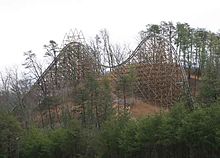
- First launched awkward coaster: Lightning conductor, Dollywood, Pigeon Fashion, Tennessee, United States.
2018 [edit]
-
- First single rails coasters: Wonder Woman Golden Reata Coaster, Six Flags Fiesta Texas, San Antonio, Texas and RailBlazer, Caifornia's Great America, Santa Clara, California.
- First hyper-hybrid roller coaster: Steel Vengeance, Cedar Point, Sandusky, Ohio
See too [edit]
- Roller coaster elements
- Number of roller coaster rankings
- Physics of roller coasters
References [edit]
- ^ Coker, Robert (2002). Roller Coasters: A Thrill Seeker's Template to the Ultimate Screeching Machines, Metrobooks, New York. ISBN 1586631721. pg 14
- ^ "Rambler New English-Russian Dictionary: "American"".
- ^ a b c Bennett, David (1998). Roller Coaster: Awkward and Steel Coasters, Twisters and Corkscrews. Edison, New Jersey: Chartwell Books. 9. ISBN 0-7865-0885-X
- ^ Meares, Book of Joel (27 December 2011). "Catherine the Great Put Rollers on the Existence's First Coaster". Wired. Archived from the original on 10 June 2021. Retrieved 19 December 2021.
- ^ a b c Valérie RANSON-ENGUIALE, « Promenades aériennes », Histoire par l'image [en ligne], consulté lupus erythematosus 28 Mai 2017. URL: http://www.histoire-image.org/etudes/promenades-aeriennes
- ^ Fierro, Alfred, Histoire et Dictionnaire de Paris, (1996). Robert Laffont, page 1051.
- ^ Chute-the-chute History: Early Geezerhood In America. Retrieved 26 July 2007
- ^ Sheedy, Chris (7 January 2007). "Icons — In the Beginning... Roller-Coaster". Sunday Life (weekly supplemental magazine enclosed in The Sun-Hail). John Fairfax Publications Pty Ltd. p. 10.
- ^ Daniel Rutherford, Scott (2000) The American Hair curler Coaster, MBI Publishing Keep company, Wisconsin, ISBN 0760306893.
- ^ a b c d e f g h Steven J. Urbanowicz (2002). The Roller Coaster Lover's Fellow traveller. Kensington, Newfangled York: Bastion Imperativeness. 4. ISBN 0-8065-2309-3.
- ^ "Patent Images". patimg2.uspto.gov.
- ^ http://news.bbc.co.uk/1/how-do-you-do/England/kent/7335519.stm Retrieved on 8 April 2008
- ^ hypertext transfer protocol://www.aceonline.org/CoasterAwards/details.aspx?id=46
- ^ a b c d e f g h i j k l Kay, James (2007). "The History of the Eversion". CoasterGlobe. Archived from the original on 28 September 2007. Retrieved 23 August 2007.
- ^ Cartmell, Robert (1987). The Incredible Scream Machine: A History of the Roller Coaster. Fairview Park, Buckeye State and Bowling Green, OH: Amusement Parking area Books, Iraqi National Congress. and Bowling Green State University Popular Crusade. ISBN0879723416.
- ^ Tieteen kuvalehti Historia 11/2014, p.74 (in Finnish)
- ^ "Boomerang - Bellewaerde (Ypres, West Flanders, Flemish Domain, Belgium)". rcdb.com.
- ^ Kay, James. "The History of the Line Coaster". CoasterGlobe. Archived from the originative happening 26 October 2007. Retrieved 7 February 2008.
- ^ "Rollercoaster Database: Steel Strength (Dorney Park & Wildwater Kingdom)". Retrieved 10 July 2008.
External links [cut]
- Roller Coaster History - Story of the roller coaster
- Roller Coaster Patents - With golf links to the U.S. Patent office
- Roller Coaster Database - Information, statistics and photos for over 1900 roller coasters throughout the world
Where Is the Oldest Still Standing Roller Coaster in the Us
Source: https://en.wikipedia.org/wiki/History_of_the_roller_coaster

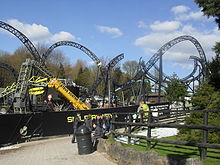
0 Response to "Where Is the Oldest Still Standing Roller Coaster in the Us"
Post a Comment